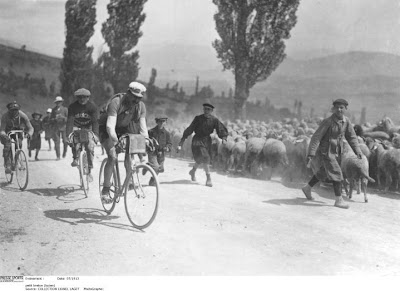Having seen the riders' protest at the concrete Belgian roads in Stage 2 (riders in the peloton refused to sprint at the finish line and crossed en masse, forcing the Tour authorities to award everyone second place) and the grimaces of pain yesterday as they rode on cobbles (which, admittedly, resembled mountain bike singletrack more than a road suited to skinny-wheeled racing bikes and which will no doubt bring a new wave of complaints), you have to wonder if they've become spoiled.
Take, for example, Stage 5 of the 1919 Tour - it covered 492km between Les Sables d'Olonne and Bayonne. That's more than three times the distance they covered yesterday. The pictures below, from an album on le Tour's official Facebook page, show just what the riders of old endured...
 Or how about if they had to schlep their own spare parts around, like this chap with his inner tubes round his neck, instead of relying on a support car stuffed full of spare wheels, bikes and anything else they might need? (Not to mention the chap on the right who, going by the goggles, is a rider himself. Cycling clothing has certainly moved on somewhat).
Or how about if they had to schlep their own spare parts around, like this chap with his inner tubes round his neck, instead of relying on a support car stuffed full of spare wheels, bikes and anything else they might need? (Not to mention the chap on the right who, going by the goggles, is a rider himself. Cycling clothing has certainly moved on somewhat). These days, the roads are cleared as le Tour passes through and all the riders need worry about is dodging the support cars and camera motorbikes (which do their utmost to keep out of the way). Horse-drawn farm vehicles are notable by their absence these days.
These days, the roads are cleared as le Tour passes through and all the riders need worry about is dodging the support cars and camera motorbikes (which do their utmost to keep out of the way). Horse-drawn farm vehicles are notable by their absence these days. Tour riders are famous for their enormous appetites (they often have difficulty adjusting to normal human food intake following retirement, which is why Eddy Merckx looks a bit like Gordon Brown these days) but no matter how desperate for food, I suspect the majority would opt for mountains of freshly-cooked pasta in the team bus rather than traditional rustic French fare in a cafe like this one. (I wonder if he's eating the boiled frogs in Belleville Rendezvous?)
Tour riders are famous for their enormous appetites (they often have difficulty adjusting to normal human food intake following retirement, which is why Eddy Merckx looks a bit like Gordon Brown these days) but no matter how desperate for food, I suspect the majority would opt for mountains of freshly-cooked pasta in the team bus rather than traditional rustic French fare in a cafe like this one. (I wonder if he's eating the boiled frogs in Belleville Rendezvous?) Night stages were dropped as the darkness provided an irresistible opportunity for riders to cheat. These days, with modern technology such as night vision goggles, they might well provide variety (though the logistics could be difficult - nobody would be able to race after a day in the saddle not the day after a night stage, so you'd have to sandwich it between two rest days).
Night stages were dropped as the darkness provided an irresistible opportunity for riders to cheat. These days, with modern technology such as night vision goggles, they might well provide variety (though the logistics could be difficult - nobody would be able to race after a day in the saddle not the day after a night stage, so you'd have to sandwich it between two rest days). Misjudge this turn in the darkness and you'd come to a sticky end - by the looks of it, that slope to the right of the road drops off sharply right behind the spectators.
Misjudge this turn in the darkness and you'd come to a sticky end - by the looks of it, that slope to the right of the road drops off sharply right behind the spectators. That dog that got onto the road on Stage 1 caused chaos. How about a whole flock of sheep?
That dog that got onto the road on Stage 1 caused chaos. How about a whole flock of sheep? If the Belgian roads and Stage 3 cobbles were enough to spark protest, how would modern riders cope with this? No idea which Tour this is, but looking at the clothes and the bike I'd guess either pre-WW1 or shortly afterwards. Remember that back then bikes were based on farmyard gate designs and had a weight to match.
If the Belgian roads and Stage 3 cobbles were enough to spark protest, how would modern riders cope with this? No idea which Tour this is, but looking at the clothes and the bike I'd guess either pre-WW1 or shortly afterwards. Remember that back then bikes were based on farmyard gate designs and had a weight to match.Back in the day, the entire race would periodically stop when the riders passed a cafe or bar that one of their number happened to know and recommend and not re-start until everyone had finished their drinks. It was also common to see riders sit up in the saddle and light a Gauloises or pipe - all things the modern, super-athletic rider avoids like the plague, of course, but one can't help suspect that despite their superhuman fitness they're a much softer and more domesticated breed than the riders of years gone by.
















No comments:
Post a Comment